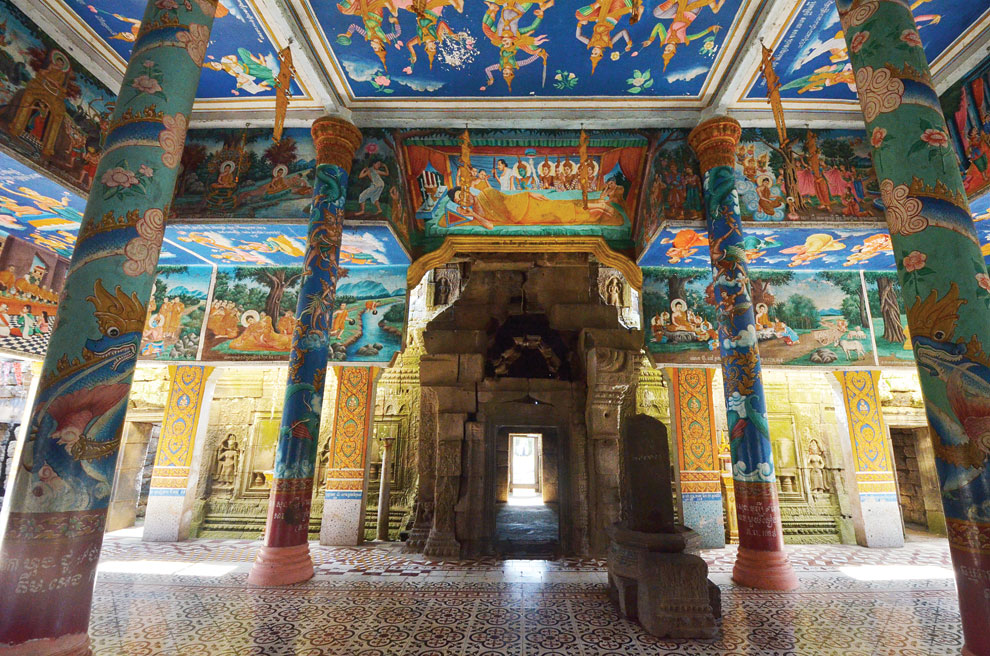
The colonial era French watchtower on the banks of the Mekong. Brent crane
Only a couple of hours by bus from Phnom Penh, the ‘harbour of the Chams’ makes for a sedate getaway with plenty to see – from Angkorian-era ruins to a pink French-built watchtower
Once a bustling Mekong River port during colonial times, Kampong Cham (“harbour of the Chams”) is now a largely sedate transit point.
Only 123 kilometres from Phnom Penh, it typically serves as a quick stopover for travellers heading to the better known tourist locales of Kratie or Mondulkiri.
It is unfortunate the place is so rarely explored; the provincial capital contains more than a few worthwhile activities for the weekend wanderer.
After a two-hour bus ride from Phnom Penh, I arrived to the “Emerald of the Mekong” around lunchtime.
Refusing the offerings of the bus stop moto drivers, I strolled down to the riverside to find a guesthouse on my own. If you can ignore the KTVs and shady massage parlors, the downtown is charming, with wide boulevards, colonial-era buildings, tree-shaded benches, a cool breeze and hardly any traffic.

The watchtower from the ground. Brent crane
Already it was worth the $6 Sorya bus ticket just to escape the hustle and bustle of city life.
For $14, I rented a room at the Moon River guesthouse.
The friendly 29-year old manager named Gecko said there were only four other guests, so I got my pick of the rooms.
“Tourists don’t come to Kampong Cham,” he frequently lamented. I chose a room on the second floor with a view of the river and the mega-sized Japanese-built Kizuna bridge.
In 2001, it became the first in the country to cross the Mekong.
I began my weekend jaunt by renting a cruiser bike from the guesthouse for $2.
Following Gecko’s suggestion, I headed south along the river, pedalling slowly to take in the sights: under the bridge and past a Chinese school, a street-side potter, a sprawling wat complex and two old-fashioned riverboat hotels.
The further I went, the more rural the landscape became; the paved road turned to dirt, stucco houses into raised wooden ones.
Two mosques and several burqa-clad women loitering in the shade indicated that I had arrived at a Cham neighbourhood.

One entrance to the atmospheric 11th-century Nokor Bachey temple.Brent crane
Through a distorting loudspeaker, an imam voiced a languid, doleful-sounding call to prayer.
Heeding the call, men trotted up the steps and into the white-walled mosque.
Meanwhile, a gaggle of half-naked tots, too young for the musalla, hollered “Helllooo!” as I cycled past.
After reaching the end of the road, I doubled back in a loop and came to the onramp of the Kizuna.
I zipped onto it and pedalled hard up the incline alongside a steady flow of trucks and motorbikes.
Soon I was looking over the whole city, the empty Mekong flowing lazily many metres below.
As I caught my breath, I peered down the bridge and spotted my destination: a pink-walled French watchtower built in the early 1900s, protruding out of the jungle like a giant Lego creation.
The ascent to the top was precarious but worthwhile: from the ancient platform, I took in splendid scenes of the green flat expanse of the Kampong Cham lowlands.
Besides the power lines, not much appeared different on this side of the river from when the French enacted their mission civilisatrice. It seemed a land frozen in time.

The 11th-century Nokor Bachey temple has a modern prayer-hall built inside of it. Brent crane
The next day I awoke at 8:30am and Gecko, who supplements his guesthouse work with a tuk-tuk, took me across town to the 11th-century Nokor Bachey temple.
Like Angkor Wat, it was built by King Jayavarman VII. But unlike Angkor, it was completely deserted and, for a $2 entrance fee, I had the whole ancient complex to myself.
Next, we sped off to see the Broh and Srey (“man and woman”) mountains. Phnom Broh was the smaller one, with a sizeable wat built on top and many skittery macaques around.
“Feed banana monkey!” was a popular refrain from local vendors.
I opted for a cup of iced sugarcane juice and observed the monkey madness from a plastic chair instead.
Phnom Srey was a five minute walk away and its ascent was the more demanding of the two, with a long slog up a steep stone staircase.
The payoff was the view from the top, which was tranquil, breezy and instead of jittery primates there were floaty butterflies.
Afterwards, Gecko and I grabbed lunch in a lazy, open-air dining hall and drove back into town, where I caught a 1:30pm bus south, to return to the tumult of Phnom Penh and nurse my sore calves.
Contact PhnomPenh Post for full article
Post Media Co LtdThe Elements Condominium, Level 7
Hun Sen Boulevard
Phum Tuol Roka III
Sangkat Chak Angre Krom, Khan Meanchey
12353 Phnom Penh
Cambodia
Telegram: 092 555 741
Email: [email protected]









